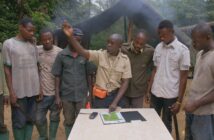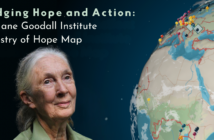I will never forget my first sighting of a wild lion. Today lions are listed as threatened, but this was far from the case when I arrived in Africa in 1957. Louis and Mary Leakey invited me to take part in a three month ‘dig’ at Olduvai Gorge, Tanzania. The Leakey’s were sure that the “Olduvan pebbles” were bolus stones, used by early hominids although, at that time, only the fossilized bones of a variety of prehistoric animals had been found – caevotherium, the forerunner of the modern giraffe, giant warthogs and baboons the size of gorillas. Gillian (another young girl who worked at the museum with me) and I had been invited to join a three month fossil hunting expedition that summer. With us were two dalmatian dogs, Bottom Biter and Toots. Toots is the champion of all breeds of Kenya, and Mary Leakey’s prized companion. Their job was to keep watch for predators when the team was crouched on all fours, searching for fossils. (Apparently, on one occasion, Bottom Biter earned his name by nipping the rear end of Mary when he sensed a nearby lion!)
After the hard day’s work Gillian and I were allowed to walk out on the plains – and Mary asked that we would take the dogs with us. On this memorable evening, as we walked along an animal trail on the floor of the gorge, a very small mouse ran across in front of us and took refuge in the vegetation below a thorn tree. The two dogs, thrilled, rushed after it.
I sensed something behind me – and looking round saw, about 300 yards away, a young male lion, probably around 2 years old, full grown, but with his mane just sprouting from his shoulders. He was standing and staring at us. He had almost certainly never seen white women, and he was curious. I had no sense of fear – just excitement. The dogs were reluctant to abandon their mouse hunt but eventually we grabbed them and, after securing them with Gillian’s belt and some string I carried in my pocket, we moved away. Fortunately the dogs never saw the lion, though he followed for some distance, only stopping when we climbed up the side of the gorge onto the open plain.
Imagine my dismay when Gillian removed her belt and Toots, champion of all breeds of Kenya, rushed back to continue her mouse hunt. We called and called. No response. I was about to climb back into the gorge – I would rather have faced the lion (who had moved out of sight) than Mary Leakey’s fury had we lost her beloved dog to a lion – when fortunately Toots, panting and mouse-less, finally returned.
It was a memorable day in more ways than one, for I truly believe that it was that evening, after I recounted our adventure around the campfire, that Louis decided I was the person he had been searching for to go study chimpanzees.






